 |
| Category:
Conflicts/WW1/Lt Horse |

|
|
|
|
|
 |
3rd/9th SOUTH
AUSTRALIAN MOUNTED RIFLES |
Lineage.
-
Adelaide Mounted Rifle Corps,
-
Adelaide Mounted Rifle Corps,
The Duke's Own Cavalry
-
South Australian Bushman's
Contingent,
-
16th Light Horse Regiment,
-
17th Light Horse
Regiment,
-
3rd Australian Light Horse Regiment AIF,
-
9th
Australian Light Horse Regiment AIF,
-
18th Australian Light Horse
Regiment ,
-
22nd Australian Light Horse Regiment,
-
24th
Australian Light Horse Regiment,
-
3rd/9th South Australian
Mounted Rifles (RAAC)
Also see 3/9
Lt Horse SAMR
|
 |
The 3/9 SAMR has the oldest surviving military title in
South Australia.
It can trace its ancestry back to 1854 when a
regiment was formed under the Volunteer Forces Act as the
Adelaide Mounted Rifle Corps.
The Year Book of South Australia
for 1854 state - 'Adelaide Forces Rifles, enrolled under the
15th Clause of the Volunteer Military Forces Act, finding their
own horses, arms, etc and receiving no pay, shall consist of one
captain, one lieutenant, one surgeon and 27 troopers'.
By 1867 the unit had progressed and was selected to
provide guards and escorts for HRH The Duke of Edinburgh on his
visit to South Australia.
After this the unit was dubbed the
'Dukes Own Cavalry'.
|
|
In the Boer War an equivalent of a squadron saw service
in South Africa with the 'Bushman's Contingent'. They first saw
action on 6th February 1900 and on the very same day three
troopers were decorated with Distinguished Conduct Medals. The
GOC in South Africa, General Methuen, wrote of the - "The
Regiment did splendid work and all ranks were cheerful under
hardships. I cannot conceive any body of men of whom a commander
had greater reason to be proud."
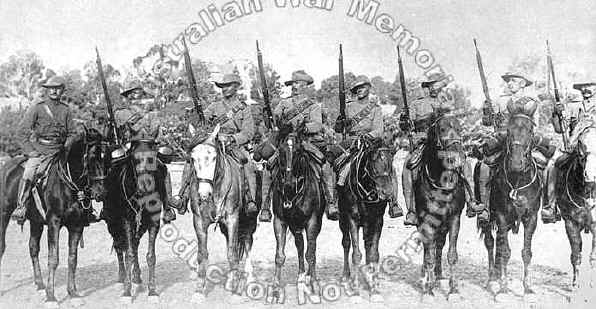
| Captain
(Capt) Edward Richman, instructor, and seven men of the
2nd South Australian (Mounted Rifles) Contingent, who
fought in the Boer War. Left to right: Capt Richman,
(later Lieutenant-Adjutant of 5th contingent); Trooper
Frederick Solly-Flood, later No. 19, Corporal, 2nd
Contingent; Trooper Harry Morant, No.
37; Trooper Hubert
Fetch, No. 51; Trooper Harry Ogilvy, No. 45; Trooper Ramsay
Nuttall, No. 49; Trooper Robert Bostock, No. 75; Trooper
William Cuttle, No. 2. Trooper Morant, later a Lieutenant
and known as "the Breaker" because of his
experience in breaking horses, was court-martialled and
executed in South Africa in 1902 for shooting Boer
prisoners, some of whom were responsible for the murder of
his friend and fellow officer, Captain Hunt. |
After the Boer War the unit expanded into two Regiments
called the 16th and 17th Australian Light Horse Regiments. In
1904 the King's Colour was presented to the 16th. This colour
was carried for many years but in 1926 it was presented to St
Augustine's Church of England, Victor Harbour. A silver plate on
the staff of this colour still carried the original inscription
'Presented by His Most Glorious Majesty, the King Emperor to the
16th Light Horse Regiment in recognition of services rendered to
the Empire in South Africa'.
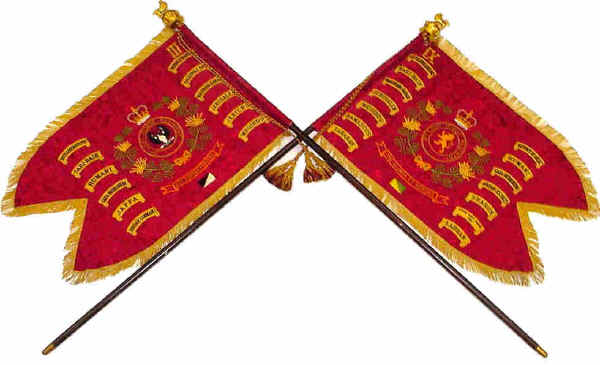
|
Guidons
of the 3rd and the 9th Light Horse |
During the 1914-1918 War there was a change in the number
of the Regiments. The 16th became the 3rd and the 17th became
the 9th Australian Light Horse Regiment. Later another change
saw them as the 22nd and the 24th. The 3rd and 9th Light Horse
served with outstanding valour during the first World War and it
is in remembrance of their bravery and sacrifice that today they
are designated 3rd/9th.
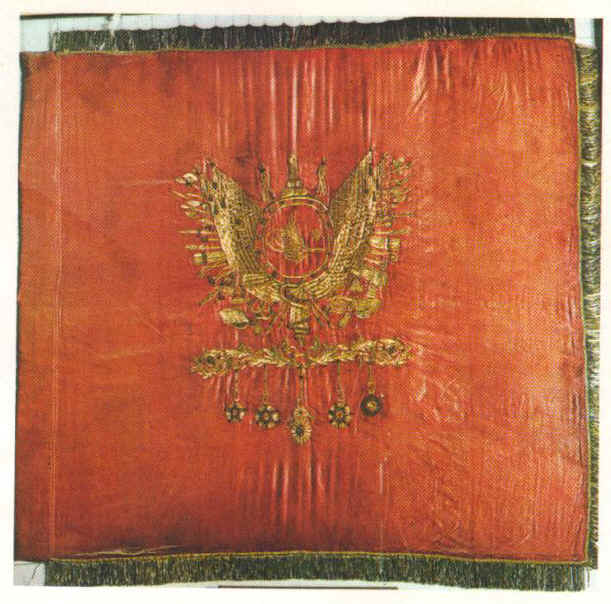 |
The 9th Light Horse Regiment has one very unique
distinction. It captured a battle standard of a Turkish Regiment
and was the only unit to capture such a standard during the
first World War.
This trophy now hangs in the Australian War
Memorial, Canberra
and is shown in the photograph to the left.
In subsequent years new numbers were bestowed on the
Regiments of Light Horse and some fresh units were formed but
throughout most of them bore the old title 'South Australian
Mounted Rifles' which was a direct link with the original unit
of 1854.
|
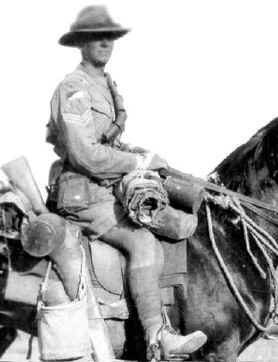 |
South Australian Sergeant
Farrier of the Adelaide Mounted rifles, wearing the
tunic, belt and Martini bandolier in the 1880s.
George Goodall was a blacksmith by
trade and he joined the South Australian Militia, and
was a member of the Adelaide Mounted Rifles. He rose to
the rank of Sergeant and on his retirement he was given
the honorary rank of Lieutenant and with permission to
retain such rank and wear the prescribed uniform.
This portrait in 1899 George GOODALL
wears the uniform of the time, which, was a locally made
brown wool tunic and breeches.
The belt is in brown
leather, as is the bandolier which carries the
individual rounds for the .303 Lee Metford.
|
|
George GOODALL was promoted to the rank
of Sergeant in 1899. The Government Gazette listed the
General Order 5/99 June 2nd, 1899; "Mounted Rifles
No. 1 Squadron, Adelaide Troops" "to be Farrier
Sergeant, No. 517 Shoeing Smith Corporal GH Goodall
(Reserve)" . Goodall text and photo from
Grants Militaria |
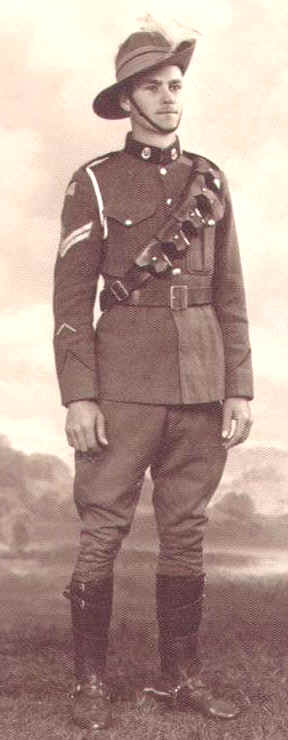 |
These units continued as Light Horse until 1940 when they
were reformed into Armoured Regiments, some of which saw active
service in the Islands during World War II.
<1930s photo of a
Corporal in the 9th Light Horse
In 1948 with the
formation of the CMF, these units were incorporated as one
regiment, the 3/9 South Australian Mounted Rifles. This unit is
now part of the Royal
Australian Armoured Corps (RAAC).
Today the Rifles operate with M113 armoured
vehicles.
Apart from our camps, weekend bivouacs, home training, some of
the unit activities in the past few years have included: the
laying up of the Queen's Colour in St Peter's Cathedral,
selection as Sovereign Guard to Her Majesty, Queen Elizabeth II
in 1954 and Vice Regal Guard to the Governor of South Australia.
On Sunday 7th February 1960 the new 3rd and 9th Light Horse
Regiment's Guidons were presented to the unit by our then
Honorary Colonel, Lt General Sir Sydney F. Rowell, KBE, CB. A
ceremonial parade was held on 14 May 1961 when the regiment
trooped the old 3rd and 9th Light Horse Guidon for the last
time, laying them up in St Peter's Cathedral.
Members of these
Light Horse regiments mounted a cavalry escort to the Guidons.
It was probably the last parade in Australian for the Light
Horse.
The history of the unit is a proud one. As the only
armoured unit in South Australia the 3rd/9th South Australian
Mounted Rifles carry on the traditions of the 3rd, 9th, 18th and
23rd Australian Light Horse Regiments as well as the earlier
volunteer regiments. |
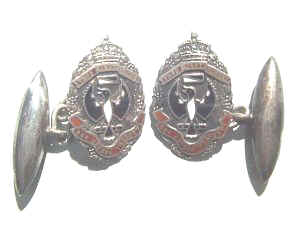 |
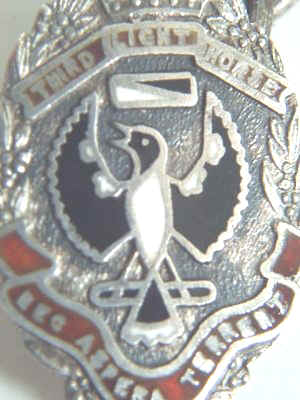 |
| Australian
3rd Light Horse silver and enamel Cuff Links, in excellent
condition, WW1 or Militia period, thereafter to WW2.
Extremely rare.
Beautifully made, marked "3rd Light Horse" with
motto, black & white color patch above Piping Shriek
bird (South Australian emblem). Cuff Link emblem resembles
1930 Light Horse Cap badge. |
Battle Honours
|
3rd
Light Horse
|
9th
Light Horse
|
| SOUTH
AFRICA, 1899-1902 |
SOUTH
AFRICA, 1899-1902 |
| DEFENCE
OF ANZAC |
DEFENCE
OF ANZAC |
| SARI
BAIR |
SARI BAIR |
| GALLIPOLI,
1915 |
GALLIPOLI,
1915 |
| ROMANI |
ROMANI |
| MAGDHABA-RAFAH |
MAGDHABA-RAFAH |
| GAZA-BEERSHEBA |
GAZA-BEERSHEBA |
| JERUSALEM |
JERUSALEM |
| JAFFA |
JORDAN
(ES SALT) |
| JERICHO |
MEGGIDO |
| JORDON
(AMMAN)
|
SHARON |
| MEGGIDO |
DAMASCUS |
|
|










